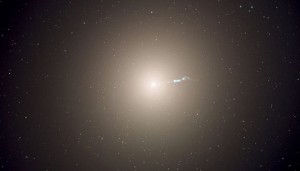Astronomers have caught a giant elliptical galaxy “shimmering” as its stars pulsate.

NASA / ESA / Hubble Heritage Team
Big galaxies are the universe’s metropolises. They’re alight with the home fires of billions upon billions of stellar residents. Looking at a galaxy is like looking down on a terrestrial city from space: we can see the stellar downtowns and suburbs, and even the layout of some neighborhoods, but we generally don’t notice the effect of individual families turning their lights on and off.
But astronomers have now done just that: they’ve measured the “shimmer” in a galaxy’s light as individual, old stars brighten and fade.
These stars are called asymptotic giant branch (AGB) stars, for the spot where they lie on the Hertzsprung-Russell stellar evolution diagram. They’re old, worn-out stars. They’ve finished converting their hydrogen cores into helium and then into carbon; all that’s left is some fusion in a couple of shells around the inert, carbon-ash core. This fusing double-shell structure is unstable, and the stars pulsate, brightening and fading over the course of several hundred days.
To detect the shimmer, Charlie Conroy (Harvard University) and colleagues took a careful look at the giant elliptical galaxy M87. This megalopolis is roughly 100 times Milky Way’s mass and filled with old stars. It lies about 50 million light-years away in the Virgo galaxy cluster and is best known for the 5,000-light-year-long jet shooting from its center.
First, the team compiled a bunch of information about the masses, luminosities, and such for stars of different ages, focusing especially on AGB stars. Second, the researchers combined that info with how much, and how fast, the different stars’ brightnesses would vary. Then, given the population of stars expected to exist in M87, and given how those stars’ pulsations would add together in the light we see, they constructed a computer simulation to predict how the individual pixels in an image of the galaxy would change in brightness over time.
Having determined what kind of patterns they might see, the astronomers then looked at a series of more than 50 images from the Hubble Space Telescope and sought out these variations. In a quarter of the pixels, the team found that the brightness went up and down enough to be clearly detected, with an average “beat” of 270 days. (The other pixels didn’t change noticeably, whether because the AGB signals just weren’t strong enough or because there were too many of them and the combined pulses smeared the beats out.)
“This paper is really very interesting,” says Claudia Maraston (University of Portsmouth, UK), who specializes in AGB stars and using them to understand galaxies. Although the detected fluctuations are very small — 0.1 to 1 percent of a pixel’s brightness — they do seem to be real. She adds that she would be glad to see this technique applied to other, younger galaxies with larger populations of variable AGB stars.
For, even though M87’s stars are old, they’re really too old to shimmer strongly. The AGB phase is a short one, only lasting a million years or so. The stars pulse more brightly the more massive they are, and since bigger stars evolve more quickly, old AGB stars (say, 10 billion years old, like the stars in M87) are going to be much fainter than young (roughly 1 billion years old) ones, Maraston explains. That means the pulsations should show up better in younger, star-forming galaxies. They should also be stronger in certain zones of a galaxy, such that we would see spiral disks shimmering more than galactic bulges or halos, which mostly have old stars, she adds.
Conroy says that the team used M87 because it was the only galaxy for which they had all the data they needed. But they’re hoping to next look at actively star-forming galaxies, so that they can see how the pulses' strength changes with a galaxy's stellar age.
Reference: C. Conroy, P. G. van Dokkum, and J. Choi. "Ubiquitous time variability of integrated stellar populations." Nature. Published online November 16, 2015.
Learn more about the science and hobby of astronomy with a subscription to Sky & Telescope magazine — available in print and digital formats.
 0
0
Comments
You must be logged in to post a comment.